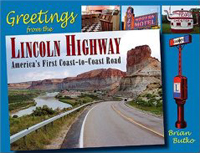Greetings From The Lincoln Highway: America's First Coast-to Coast Road, by Brian Butko
The Lincoln Highway, "America's Main Street" is approximately 3,400 miles long and travels through fourteen states. New York claims the shortest piece of Lincoln Highway with only one mile inside its borders. Nevada, Nebraska and Wyoming have the longest stretches -- each has over 400 miles. While Henry Joy generally gets the credit for naming the road, it was quite interesting to learn that Frances McEwen Belford, a Colorado politician, introduced a bill in Congress in September, 1911, calling for the creation of a "Lincoln Memorial Highway between Boston and San Francisco" years before the official proclamation of the new highway on September 14, 1913.
Butko does an excellent job of weaving in historical detail gathered from the published journals of early travelers together with his own discoveries in the 21st century. Beyond the often humorous tales told by those hardy automotive pioneers, the author vividly conveys the complex story of the infighting and intense gamesmanship that went on as local politicians and business leaders sought to gain the prestige of having the first transcontinental highway pass through their jurisdictions.
One tangible result of the infighting is that there is no one route. Different factions within the state governments and the Lincoln Highway Association kept revising the route over its lifetime, and among the best features of this book are the color maps Butko uses to detail the generational changes for the route in each of the states. The story of the highway is told from east to west, with the opening chapter discussing the original eastern terminus at Times Square and then progressing westward all the way to the parking lot at the California Palace of the Legion of Honor in San Francisco, which at one time was fittingly known as Land's End.
While not specific enough to use exclusively to physically navigate the entire route across the country, the book has more than enough detail to travel the Lincoln Highway by armchair. A fabulous addition to any coffee table, the book has over 400 gorgeous color and black-and-white photographs, vintage postcard reproductions and snippets from the memoirs of early travelers. That would be enough to make this book worthwhile, but it is the author's prose and meticulous research that is the real delight. Butko shares the stories and secrets of a legendary road that we as modern travelers would never discover on our own. For instance, near New Carlise, Indiana, there is a field adjacent to the highway studded with an assemblage of 8,259 pine trees. These trees were planted to spell out the word "Studebaker," making the forest the largest living advertising sign in the world. Legible only from the air, it's a roadside marvel you could drive by forever without ever learning its secret.
Two other elements that I will be looking for after reading this book are the phenomena known as "Seedling Miles" and the "Ideal Segment." The Lincoln Highway engineers made a point of choosing particularly bad sections of dirt road. Then they built pristine concrete highways for a mile or so -- "Seedling Miles" -- as a way of inspiring the local citizenry to encourage local governments to pave the rest of the roadway. The "Ideal Segment" was a 1.3-mile stretch between Schereville and Dwyer, Illinois, that was built between 1921 and 1923 to showcase the latest concepts in highway design, landscaping and lighting.
Much of the Lincoln Highway has been incorporated into modern highway routes and obliterated, but there are still sections that are in nearly the same condition as they were in the early 1920s. In Iowa, nearly 85% of the route has been bypassed by modern highways and can still be driven. Surprisingly, much of the surviving route throughout the country is still dirt. Also surprising is that quite a few of the roadside motels and attractions that were popular in the 1920s are still open and serving customers today. Butko does a great job of matching historical perspectives with current-day observations for many of these operations.
Whether you are an armchair traveler or a back-road wanderer, this visually appealing, easy-reading, high-quality hardback book will delight, educate and enrich your understanding of America's original cross-country highway. It really is an American classic and one that belongs in every road lore enthusiast's personal library.
Mark
Sedenquist
3/26/06

